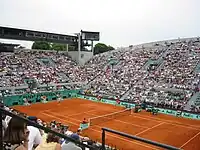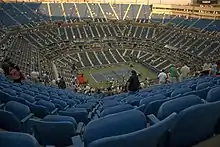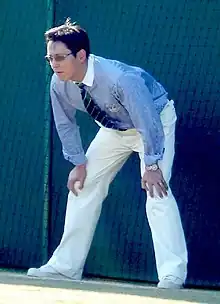| This Wikipedia page has been superseded by Portal:Tennis and is retained primarily for historical reference. |
| Note: Article entries are now being transcluded directly on the main portal page. However, this page should be retained for historical reference. |
Usage
The "Selected Article" box on the Portal page is randomly generated with the Random Portal Component template. To add an article to be randomly selected, you must:
- Find the next available subpage number from the list of articles below
- Make a new subpage of this page with that number (Portal:Tennis/Selected article/<# here>)
- Write a summary of the article using the layout design at Portal:Tennis/Selected article/Layout
- Link to the new subpage at the bottom of the list below, like the other subpages
- Update the "max=" attribute on the {{Random portal component}} in the "Selected Article" box on the main page to the number of the subpage you created
Selected article 1
Portal:Tennis/Selected article/1 Radio Wimbledon is the official radio station to the annual Wimbledon Tennis Championships at the AELTC in Wimbledon. It broadcasts daily on 87.7FM between 8am and approximately 10pm during the Championships at Wimbledon. Broadcast from specially designed studios near the Press Centre at the AELTC, it is available in an area approximately within a 5 mile radius of the AELTC under a Restricted Service Licence, as well as online through Wimbledon.org.
Selected article 2
Portal:Tennis/Selected article/2

The tournament is held in the London suburb of Wimbledon, England, at The All England Lawn Tennis and Croquet Club (commonly referred to as the All England Club). It is held annually from late June to early July. The tournament is calendared so that it ends on the second Sunday of July and begins on the Monday, 13 days earlier. It is the third Grand Slam tournament played each year. It is preceded by the Australian Open, which is played on hard courts, and the French Open (Roland Garros), which is played on clay courts. It is followed by the U.S. Open, which is played on hard courts.
Selected article 3
Portal:Tennis/Selected article/3

Selected article 4
Portal:Tennis/Selected article/4

Selected article 5
Portal:Tennis/Selected article/5

The US Open differs from the other three Grand Slam tournaments (Australian Open, French Open, Wimbledon Championships) in that there are final-set tiebreaks. In the other three majors, the fifth set for the men and the third set for the women continue until someone wins by two games.
Selected article 6
Portal:Tennis/Selected article/6

The Medieval form of tennis is termed real tennis. Real tennis evolved over three centuries from an earlier ball game played around the 12th century in France. This had some similarities to palla, fives, pelota, or handball, involving hitting a ball with a bare hand and later with a glove. One theory is that this game was played by monks in monastery cloisters, based on the construction and appearance of early courts. By the 16th century, the glove had become a racquet, the game had moved to an enclosed playing area, and the rules had stabilized. Real tennis spread in popularity throughout royalty in Europe and reached its peak in the 16th century.
In France, François I (1515-47) was an enthusiastic player and promoter of real tennis, building courts and encouraging play among the courtiers and commoners. His successor, Henri II (1547-59) was also an excellent player and continued the royal French tradition. During his reign, the first known book about tennis, Trattato del Giuoco della Palla was written in 1555 by an Italian priest, Antonio Scaino da Salo. Two French kings died from tennis related episodes--Louis X of a severe chill after playing and Charles VIII after being struck with a ball. King Charles IX granted a constitution to the Corporation of Tennis Professionals in 1571, creating the first pro tennis 'tour', establishing three levels of professionals-- apprentice, associate, and master. The first codification of the rules of real tennis was written by a professional named Forbet and published in 1599.
Selected article 7
Portal:Tennis/Selected article/7

At the highest levels of the sport a team of up to ten officials may be on court at any given time. These officials are broken up in to categories based on their responsibility during the match. Contrastingly, many tennis matches are conducted with no officials present.
The Chair Umpire "is the final authority on all questions of fact during the match." Questions of fact include whether or not a ball was in, the calling of a service let or the calling of a foot-fault.
The Line Umpire "calls all shots relating to the assigned lines." Line umpires work on court as part of a team of between three and nine line umpires. Each line umpire is assigned by the chair umpire to one line or, in the case of a short handed crew, a position in a system. For example, a line umpire on the receiver's side may have to cover the center service line then, following the serve, move to one of the sidelines.
Selected article 8
Portal:Tennis/Selected article/8 In tennis, a player uses different strategies that both enhance his own strengths and exploit his opponent's weaknesses in order to gain the advantage and win more points. Players commonly specialize in a certain style of play, focusing on what they do best as a means of beating their opponents. Based on their style, players generally fit into one of three types: baseliners, volleyers and all-court players. A baseliner plays from the back of the tennis court, around the baseline, preferring to trade groundstrokes rather than to come up to the net (except in certain situations). A volleyer tries to approach the net and hit volleys, putting pressure on the opponent. All-court players fall somewhere in between. A tennis player usually determines his/her strategies based on his/her weaknesses. For example, most players have a stronger forehand, therefore they will hit forehands "inside out" to their opponents.
Selected article 9
Portal:Tennis/Selected article/9
.jpg.webp)
The material used in tennis string can significantly change the performance of a racquet, especially for advanced players. Thus, several different compounds are used to make tennis strings, varying in terms of playability, durability, and "feel," among other considerations.
Natural gut is considered by many to be the best string in terms of overall playability, as it offers both power and control over the ball. However, natural gut breaks easily and is the most expensive kind of string; thus, it is usually used by professional tennis players. The first natural gut tennis string was manufactured in 1875 by Pierre Babolat, who would launch the VS brand of gut fifty years later.
Selected article 10
Portal:Tennis/Selected article/10

Federer and Nadal are the only pair of men to have finished six consecutive calendar years as the top two ranked players on the ATP Tour, from 2005–2010. Federer was ranked No. 1 for a record 237 consecutive weeks beginning in February 2004. Nadal, who is four years and ten months younger, ascended to No. 2 in July 2005 and held this spot for a record 160 consecutive weeks before surpassing Federer in August 2008. Federer regained the No. 1 ranking in June 2009, due in part to Nadal's injury hiatus, which also caused Nadal to briefly fall to No. 3. Nadal returned to No. 2 in September but dropped two spots in February 2010, and regained the World No. 2 after winning the Mutua Madrileña Madrid Open in May 2010 (against Federer in the final). After winning the 2010 French Open, Nadal regained the No. 1 position again.
Nadal leads their overall head-to-head series 23–10. Because tournament seedings are based on rankings, 20 of their matches have been in tournament finals, including an all-time record 7 Grand Slam finals. From 2006 to 2008 they played in every French Open and Wimbledon final, and then they met in the 2009 Australian Open final. Nadal won five of the seven, losing the first two Wimbledons. Three of these matches lasted five sets (2007 and 2008 Wimbledon, 2009 Australian Open), and the 2008 Wimbledon final—which Nadal won—has been lauded as the greatest match ever by many long-time tennis analysts. They have also played in a record 9 Masters Series finals, including their lone five hour match at the 2006 Rome Masters which Nadal won in a fifth-set tiebreak.
Selected article 11
Portal:Tennis/Selected article/11

The Gentlemen's Singles event was the only competition held and was contested by 22 competitors who paid one guinea entrance fee. The grass court tournament started on Monday, 9 July 1877 and the final, which was delayed three days due to rain, took place on Thursday, 19 July in front of a crowd of about 200 people. The spectators paid an entry fee of one shilling each, and the prize money for the winner was 12 guineas, plus a silver challenge cup valued at 25 guineas donated by the sports magazine The Field. Spencer Gore, a 27-year old rackets player from Wandsworth, won the first Wimbledon title, after defeating William Marshall, a 28-year old real tennis player, in three straight sets in the final that lasted 48 minutes. The tournament made a profit of £10.
Selected article 12
Portal:Tennis/Selected article/12 The New York Sportimes were a professional tennis team competing in World TeamTennis (WTT). The team was originally based in eastern Long Island from 2000 to 2002, before moving to Westchester County, New York in 2003, and then to New York City in 2009. The team was founded as the New York Hamptons in 2000, before changing its name to the New York Sportimes in 2003. In 2005, the team made its first playoff appearance and went on to defeat the Newport Beach Breakers in the WTT Final to win its first King Trophy.
On February 14, 2011, WTT announced that the New York Sportimes and New York Buzz had merged and would play the 2011 season as the New York Sportimes. In the three seasons following the merger, the Sportimes played 12 home matches in New York City and nine in the Capital District. On January 16, 2014, Claude Okin, CEO of the New York Sportimes announced that the franchise had been sold to businessman Russell Geyser, and the team would be relocated to San Diego, California and renamed the San Diego Aviators.